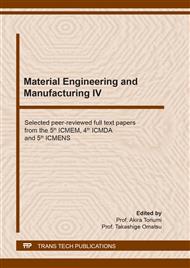p.45
p.52
p.58
p.66
p.72
p.81
p.87
p.94
p.103
Study on Finishing of Polychlorotrifluoroethylene Resin by Magnetic Abrasive Finishing Process with Renewable Abrasive Particles
Abstract:
Polychlorotrifluoroethylene material is used in industry as a material with excellent insulation, impact resistance and acid and alkali resistance. In this study, we used a magnetic abrasive finishing process with renewable abrasive particles to finish the surface of the polychlorotrifluoroethylene resin plate. Magnetic Abrasive Finishing (MAF) process is a technology that uses flexible magnetic brushes to improve the surface quality of materials. The performance of the magnetic brush is a key factor in surface finishing. In conventional MAF finishing, the number of abrasive particles in the magnetic brush is limited, and the position of the abrasive particles is relatively fixed, which will cause the cutting edge of the abrasive particles to gradually become dull and the finishing efficiency gradually decreases. This paper research the characteristics of the MAF process with renewable abrasive particles. This MAF process has a circulating system that uses a conveyor belt to renew abrasive particles. We use the polychlorotrifluoroethylene resin plate as the experimental processing object to conducted finishing experiment. And the surface roughness of the polychlorotrifluoroethylene resin plate is improved from 315 nm to 32 nm through this process.
Info:
Periodical:
Pages:
72-77
Citation:
Online since:
September 2021
Authors:
Price:
Сopyright:
© 2021 Trans Tech Publications Ltd. All Rights Reserved
Share:
Citation:


